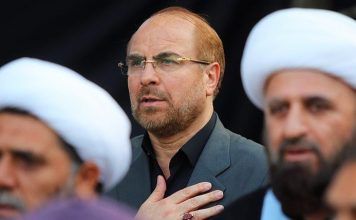By Kayhan Life Staff
The Islamic Revolutionary Guards Corps (IRGC) has successfully test-fired ballistic missiles buried deep below ground, without the use of an underground silo, blast doors, or launch pads, Brigadier General Amir-Ali Hajizadeh, the commander of the IRGC’s Aerospace Force, has said.
[aesop_image img=”https://kayhanlife.com/wp-content/uploads/2020/08/رزمایش-4.jpg” panorama=”off” credit=”Test-firing of ballistic missiles buried deep below ground. Kayhan London” align=”center” lightbox=”on” captionsrc=”custom” captionposition=”left” revealfx=”off” overlay_revealfx=”off”]
General Hajizadeh made the comments during the last phase of the IRGC’s “Great Prophet-14” naval exercises in the Persian Gulf and the Strait of Hormoz on July 28.
“As always, the IRGC unveiled several new military innovations during the recent naval maneuvers, including test-firing ballistic missiles — for the first time in the world — from deep below the ground,” commander Hajizadeh was quoted by the Mehr News Agency as saying. “During the Great Prophet-14 exercises, our forces fired missiles buried deep below the ground, without the use of the usual hardware [underground silo, blast doors] and launch pads. The missiles burst out of the ground and hit their targets with great precision.”
“The drill involved attacking a target with anti-radiation missiles. Aerospace Force’s drones also fired missiles, hitting a mock-up of a U.S. carrier,” Hajizadeh added.
[aesop_image img=”https://kayhanlife.com/wp-content/uploads/2020/07/2020-07-27T071753Z_7835386_RC2J1I9W8Y85_RTRMADP_3_IRAN-USA-CARRIER-scaled.jpg” panorama=”off” credit=”Iran’s refurbished mockup aircraft carrier, used previously as a simulated U.S. target during a February, 2015 Iranian naval war games exercise, is seen at its home port of Bandar Abbas, Iran February 15, 2020. Satellite image ©2020 Maxar Technologies/via REUTERS ” align=”center” lightbox=”on” captionsrc=”custom” captionposition=”left” revealfx=”off” overlay_revealfx=”off”]
In a tweet dated July 29, Hajizadeh said: “Underground ballistic missiles during Great Prophet-14 maneuvers. The name and description of the missile is a secret. #missile-farm.”
The accompanying footage to the tweet showed several ballistic missiles being fired from what appeared to be underground silos.
The U.S. Central Command (CENTCOM) has, however, described the ballistic missile tests as another provocative act by the IRGC.
“The safety and resilience of our service members and coalition partners is a top priority,” said Navy Captain William Urban, spokesman for the CENTCOM, was quoted by the online USA Today daily as saying. “The U.S. condemns these irresponsible missile launches near a congested maritime shipping lane.”
What the IRGC high command has described as a groundbreaking military innovation is a poor imitation of an outdated U.S. missile launch system initially designed in 1963. The program was in use for 20 years but was eventually abandoned during the presidency of Ronald Reagan (whose term lasted from 1981 to 1989).
Underground missiles silos posed several problems which resulted in the U.S. military to discontinue their use. These included high temperatures that damaged the missile, the launch pad, and the engine.
Some military analysts closely linked to the Iranian regime claim that the IRGC has eliminated the need for a silo by placing the missile inside a capsule that significantly reduces temperatures and cools the engine.
Although commander Hajizadeh’s so-called “missile farm” is a poor imitation of an outdated U.S. technology, it could pose severe danger to commercial shipping in the Persian Gulf and Strait of Hormoz waterways.
Meanwhile, U.S. media report that the Senate Foreign Relations Committee plans to question U.S. Secretary of State Mike Pompeo on recent naval maneuvers by the IRGC in the Persian Gulf and on rising tensions between Washington and Tehran.
On July 30, the Senate Foreign Relations Committee grilled Mr. Pompeo on a wide range of issues, including the U.S. administration’s China and Russia policies and the decision to pull 12,000 American troops out of Germany. It was the first time in 15 months that Pompeo had appeared before the committee.
This article was translated and adapted from Persian by Fardine Hamidi.







